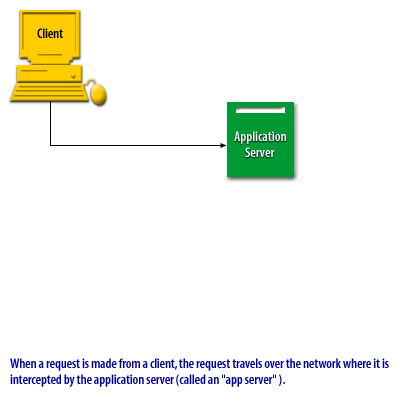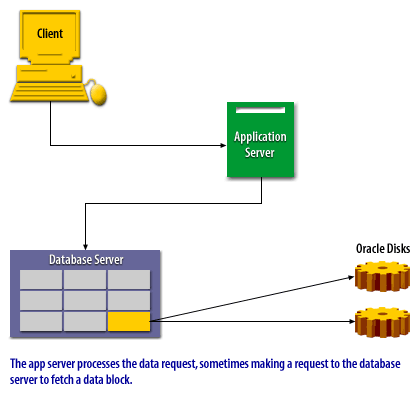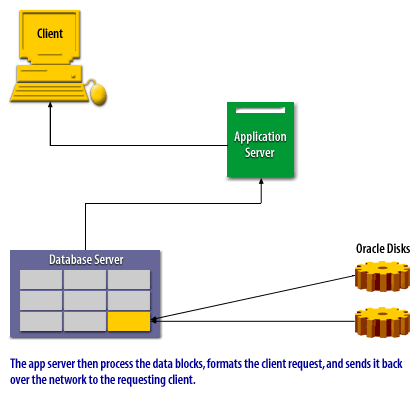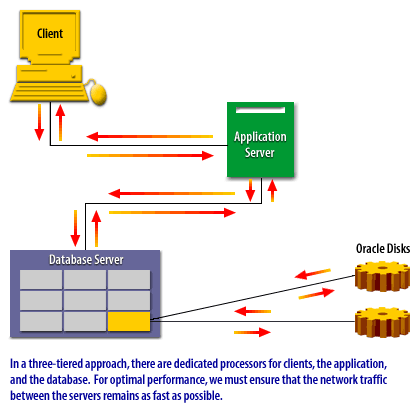| Lesson 4 | Network considerations with Oracle performance |
| Objective | Explain architecture-related performance factors |
Oracle Performance Network Considerations (architecture-related)
In today's environment, it is rare to see monolithic database systems
that perform all of the processing for an application. Rather, we tend to see distributed environments that may consist of two-tiered or
three-tiered client-server architectures. In a three-tiered client-server architecture, we have three layers:
- the database server,
- the application servers, and
- the clients.




We will discuss this in detail in a later module. In a distributed Oracle environment, we have a network administrator who ensures that network traffic remains optimized. The Network Administrator is responsible for all aspects of network configuration and network traffic.
The next lesson looks at disk I/O.
Oracle Database Application Clusters
Advantages of using a multi-tiered system for an organization's database structure
Using a multi-tiered system for an organization's database structure has several advantages compared to having one large table or database. Here are some key benefits:
Conclusion A multi-tiered database architecture offers enhanced scalability, performance, security, and maintainability, making it more suitable for large or growing organizations. In contrast, a single large table or database may lead to performance bottlenecks, security risks, and difficulties in managing complexity as the system grows.
- Improved Scalability:
- Multi-tiered systems allow you to scale different parts of the system independently. For example, the data access layer and business logic layer can be scaled horizontally (adding more servers) without affecting the presentation layer or user interface.
- A single large database can become a bottleneck when scaling, as adding more data can slow down query performance.
- Enhanced Security:
- In a multi-tiered system, security policies can be enforced at different layers, limiting access to certain components. For example, the presentation layer may not have direct access to the database, thus reducing the risk of SQL injection attacks.
- Segregating data access to a specific layer allows better control over who or what can access sensitive data.
- Separation of Concerns:
- Each layer (e.g., presentation, business logic, data access) has a well-defined role, which makes the system easier to maintain and extend. Changes in one layer (such as altering the user interface) do not necessarily require changes in the database or business logic layers.
- A large, monolithic database design can entangle concerns, making updates and bug fixes more difficult and error-prone.
- Better Performance Optimization:
- In a multi-tiered architecture, performance bottlenecks can be identified and optimized at specific layers. For example, you can use caching at the middle layer to reduce database load or optimize queries at the data layer to improve performance.
- Large databases can slow down as query complexity increases, while distributing workloads across tiers can reduce database load and improve response times.
- Easier Maintenance and Updates:
- Changes to business rules or data validation logic can be made in the business logic layer without affecting the data access or presentation layers. This modularity reduces the complexity of updates and maintenance.
- With a single, large database, every change requires careful consideration of how it will affect the entire system, making updates more complex and risky.
- Reusability:
- Components or services in a multi-tiered architecture (like APIs or data access layers) can be reused across multiple applications or projects. This results in faster development cycles and fewer redundancies.
- A single large database typically has fewer reusable components, as everything is tightly coupled to a specific application.
- Data Integrity and Management:
- A multi-tiered architecture can better enforce data integrity rules by separating the data access from the business logic. It is easier to implement validation checks, consistency rules, and backup processes when the database is part of a larger, structured system.
- Managing data integrity in a single large table or database can be more difficult as the complexity grows, especially if various parts of the application interact directly with it.
- Flexibility in Database Design:
- Multi-tiered systems allow you to use different databases for different parts of the system. For instance, the transactional database might be in SQL, while analytics or data warehousing could use a NoSQL or specialized database system.
- A large, single database usually locks you into a specific data model and technology, limiting flexibility and making future changes harder.
- Distributed Development:
- Teams can work on different layers (e.g., frontend developers focus on the presentation layer, while backend developers work on the business and data access layers), allowing parallel development and improving productivity.
- With a single large database, developers need to be more tightly coordinated, as changes in one part of the system could have far-reaching effects.
- Failover and Redundancy:
- A multi-tiered architecture allows you to implement redundancy and failover mechanisms at different tiers. If one component fails, others can continue to function, and load balancing can route traffic to working servers.
- A single large database creates a single point of failure, and if it becomes corrupted or unavailable, the entire system may go down.
Conclusion A multi-tiered database architecture offers enhanced scalability, performance, security, and maintainability, making it more suitable for large or growing organizations. In contrast, a single large table or database may lead to performance bottlenecks, security risks, and difficulties in managing complexity as the system grows.
Role of a Network Administrator in an Oracle Environment
A network administrator in an Oracle environment plays several critical roles, though their primary focus might not be directly on Oracle database administration but rather on ensuring the network infrastructure supports the Oracle environment effectively. Here are the key responsibilities they might handle:
The network administrator might not delve deep into the database internals like a database administrator would, but their role is crucial for ensuring that the network layer of the Oracle environment is robust, secure, and optimized. This support indirectly contributes to the overall performance, security, and reliability of the Oracle database systems.
- Network Configuration and Management:
- Connectivity: Ensuring that the Oracle servers, clients, and other components of the Oracle environment are properly connected across the network. This includes setting up and managing Oracle Net Services (formerly known as SQL*Net) for smooth communication between the database and its clients.
- Firewall and Security: Configuring firewalls to allow necessary traffic for Oracle connections while safeguarding against unauthorized access. This includes setting up rules for Oracle's database listener ports.
- Performance Optimization:
- Bandwidth Management: Ensuring that there's sufficient bandwidth for Oracle operations, especially for data-intensive tasks like backups, replication, or data loading processes.
- QoS (Quality of Service): Prioritizing network traffic to ensure critical Oracle operations like real-time transaction processing or data replication aren't hindered by other network traffic.
- Security:
- Encryption: Implementing network encryption protocols like SSL/TLS for securing data in transit between Oracle clients and servers.
- Access Control: Managing network access controls to prevent unauthorized access to the Oracle databases, which might involve setting up VPNs or other secure remote access solutions.
- Monitoring and Troubleshooting:
- Network Monitoring: Continuously monitoring network performance to quickly identify and resolve issues that might affect Oracle database operations.
- Troubleshooting: Diagnosing network-related issues that might be causing database connectivity problems or performance degradation.
- Disaster Recovery and High Availability:
- Network Redundancy: Setting up redundant network paths to ensure high availability, which is crucial for Oracle environments configured for high availability like Oracle RAC (Real Application Clusters).
- Failover Management: Ensuring the network infrastructure supports quick failover mechanisms for Oracle databases, such as Data Guard configurations.
- Integration with Other Network Services:
- DNS and DHCP: Ensuring proper DNS entries for Oracle servers and perhaps managing DHCP for dynamic IP assignment, if relevant.
- Load Balancing: Configuring network load balancers to distribute database traffic efficiently, especially in multi-node Oracle setups.
- Support for Oracle-Specific Network Features:
- Oracle Coherence: If Oracle Coherence (a distributed caching system) is in use, ensuring the network setup supports its requirements for low latency and high throughput.
- Oracle Exadata: For Oracle Exadata environments, ensuring the network infrastructure supports the specific networking requirements, like InfiniBand for high-speed data transfer.
The network administrator might not delve deep into the database internals like a database administrator would, but their role is crucial for ensuring that the network layer of the Oracle environment is robust, secure, and optimized. This support indirectly contributes to the overall performance, security, and reliability of the Oracle database systems.